I’ll Start When the Time Is Right…
For years, I told myself, I’ll start when the time is right. When I’ve got more experience, more confidence, when Mercury isn’t in retrograde, and my life feels like one of those perfectly curated Instagram posts.
Guess what? That day never came.
And here’s the kicker: nobody was waiting for me to feel ready. No one was like, “Oh, Sal’s not confident yet? Let’s all just hit pause on everything.” Life kept moving, opportunities passed, and I stayed stuck in this loop of not yet.
Eventually, I realized: starting doesn’t require perfection. It just requires action. The more you wait for the “perfect moment,” the more time you lose. And the more time you lose, the harder it gets to start. It’s a vicious little cycle.
So here’s my advice—don’t wait for perfect conditions. The universe doesn’t care if you’re 100% ready. Get messy. Make mistakes. Start before you feel like you’re qualified. Because guess what? That’s how you learn, grow, and become qualified.


